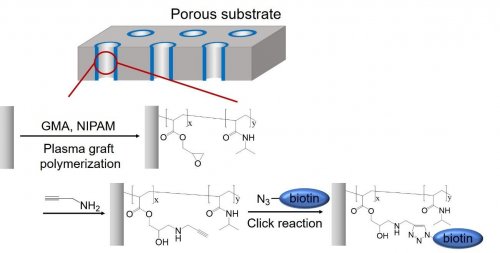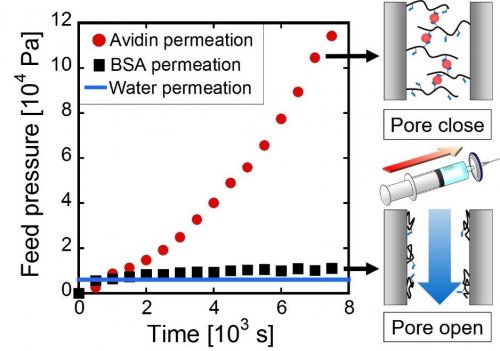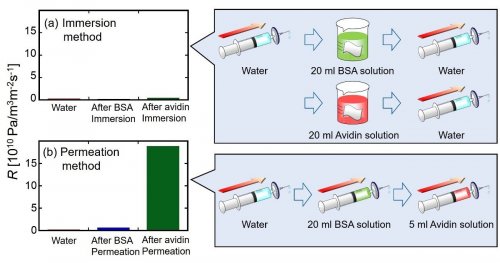Latest Research
- 2018.02.01
- Yamaguchi-Kuroki Group
High-sensitive Molecular Detection Using Biomolecule-Recognition Gating Membrane with Small Pore Space for Disease Diagnostics
For the imminent aging population, an easy and shot-time detection of diseases performed at the patient's home or bedside (point-of-care testing, POCT) attracts much attention. To realize the full potential of POCT, a simple device for rapid detection of weaker signals from target biomarker molecules is still required.
 Fig. 1 Scheme for preparing molecule-recognition gating membrane with Click reaction.
Fig. 1 Scheme for preparing molecule-recognition gating membrane with Click reaction.
In one approach, membrane sensors that use their pores as a recognition site is been proposed. We have developed a novel biomolecule-recognition gating membrane that controls the open-closed state of its pores by multi-point recognition of the target biomolecule and the consequent formation of cross-linking. [1] This amplification mechanism identified has demonstrated to have potentially as higher specificity as currently available detection systems according to chemical engineering model calculations. Meanwhile, for commercially utilizing this membrane in POCT, it is necessary to construct the basis for applying this detection system to other target-receptor pairs with comparable high sensitivity. Therefore, in this study, we aim to improve both versatility and sensitivity of the gating membrane with two approaches. [2]
With efficient introduction of receptor molecules into the pores of the porous membrane regardless of the type of the compound, the target of the gating membrane can be extended further. Here, we introduce the receptor molecules via highly reactive and selective "Click reaction" [3,4] as shown in Fig. 1. The copolymers of N-isopropylacrylamide and glycidylmethacrylate (GMA) is initially immobilized into pores of polyethylene porous substrate by plasma-induced graft polymerization [5, 6]. After the graft polymerization, a terminal alkyne group is introduced into the epoxy group of the GMA followed by a biotin compound (receptor molecule) into the copolymer via Click reaction. From the results of weight change of the membrane and FT-IR analysis, biotin compounds were found effectivity introduced into the submicron-sized pores, with approximately 90% conversion using the Click reaction.
In our biomolecule-recognition gating membrane, target biomolecules were recognized via membrane immersion in a sample solution (immersion method). [1] However in this method, the molecular recognition moieties inside the pores have not been used effectively. Hence, we have developed an efficient and simple molecular recognition method by permeating sample solution through the gating membrane (permeation method). Figure 2 shows the change in feed pressure after permeation by water, bovine serum albumin (BSA) solution, and the avidin solution at 45 oC using membranes prepared by the proposed method. Although there is almost no feed pressure change in the permeation of control protein, BSA, there is a pressure change during avidin permeation. This suggests a gradual closing of the pores occurring due to the multi-point binding between avidin and graft copolymers demonstrating the successful detection of the target molecules without temperature signal.
 Fig. 2 Time dependence of feed pressure as each sample solution permeated in the permeation method.
Fig. 2 Time dependence of feed pressure as each sample solution permeated in the permeation method.
Then permeation resistance R, which is defined as reciprocal of permeation flux normalized to the measured feed pressure, was calculated based on the permeation test of both immersion method and permeation test (Fig. 3). While using the immersion method, the R-value after immersion in the avidin solution is only two times that of after immersion in the BSA solution (Figure 3a). In contrast, in the permeation method, the R-value after permeation by avidin solution is approximately 30 times higher than after permeation by BSA solution (Figure 3b). This result can be explained by the difference in recognition efficiency, where the permeation method achieves more effective recognition than the immersion method due to the direct delivery of avidin into the pores via convection flow, and consequently greater avidin amounts coming in contact with biotin.
 Fig. 3 Permeation resistance before and after molecular recognition test at 45 oC using a) immersion method and b) permeation method.
Fig. 3 Permeation resistance before and after molecular recognition test at 45 oC using a) immersion method and b) permeation method.
In summary, molecular recognition receptors are been effectively introduced into the submicron-sized pores of biomolecule-recognition gating membranes using a versatile Click reaction. This scheme allows using a range of molecular recognition receptors, such as polyclonal antibodies and DNA. In addition, the permeation method, which actively delivers the target molecules into the pores by convection, shows higher sensitivity than the immersion method. This permeation method using the biomolecule-recognition gating membrane enables a simple, efficient, and sensitive molecular recognition, making this membrane sensor a promising candidate for POCT applications.
References,
1) H. Kuroki, T. Ito, H. Ohashi, T. Tamaki, T. Yamaguchi, Anal. Chem., 83, 9226(2011).
2) H. Okuyama, Y. Oshiba, H. Ohashi, T. Yamaguchi, Small, in press.
3) H. C. Kolb, M. G. Finn, K. B. Sharpless, Angew. Chem.-Int. Edit., 40, 2004(2001).
4) J. F. Lutz, Angew. Chem.-Int. Edit., 46, 1018(2007).
5) T. Yamaguchi, S. Nakao, S. Kimura, Macromolecules, 24, 5522(1991).
6) X. Q. Chi, H. Ohashi, T. Yamaguchi, Plasma Process. Polym., 11, 306(2014).



